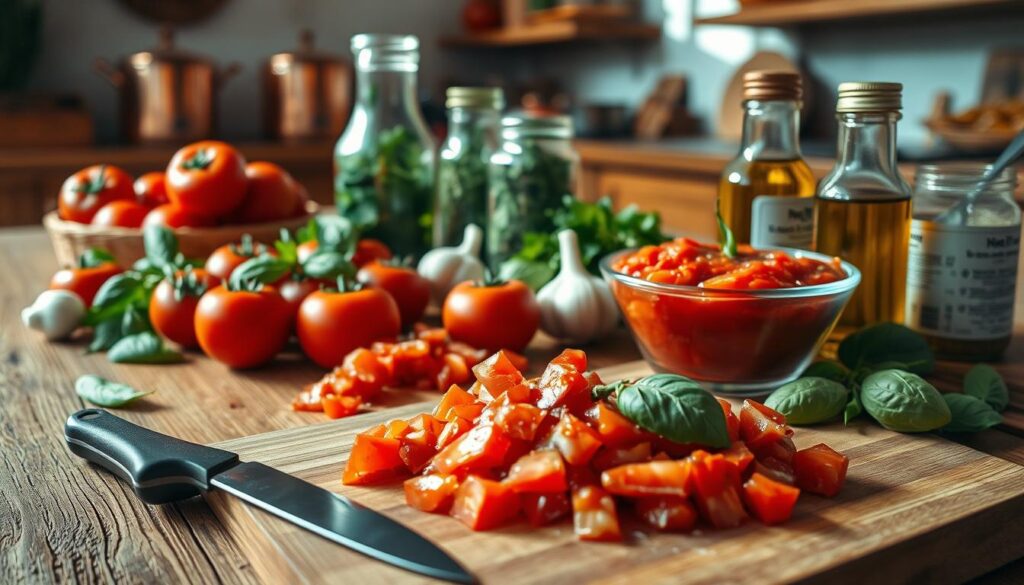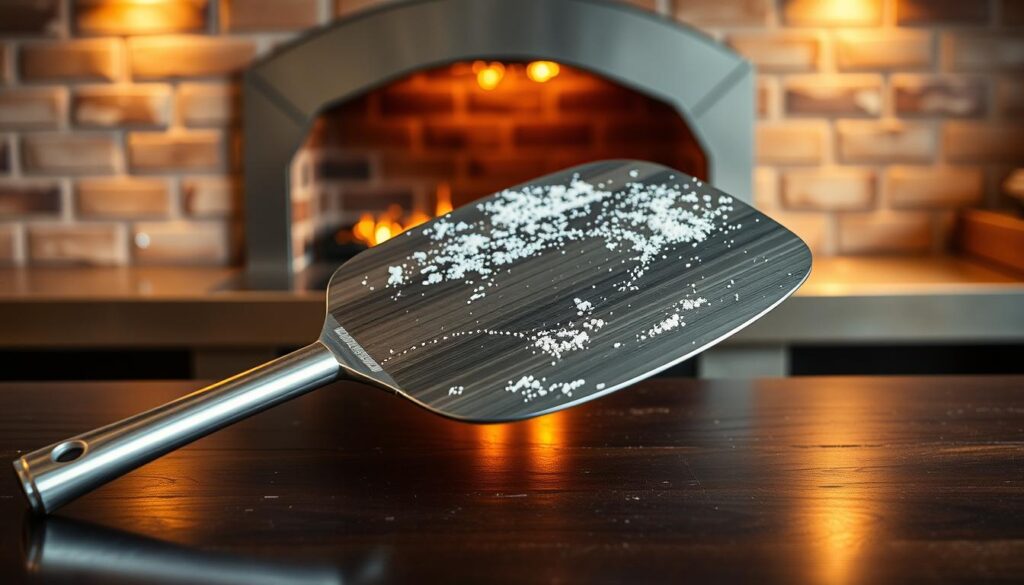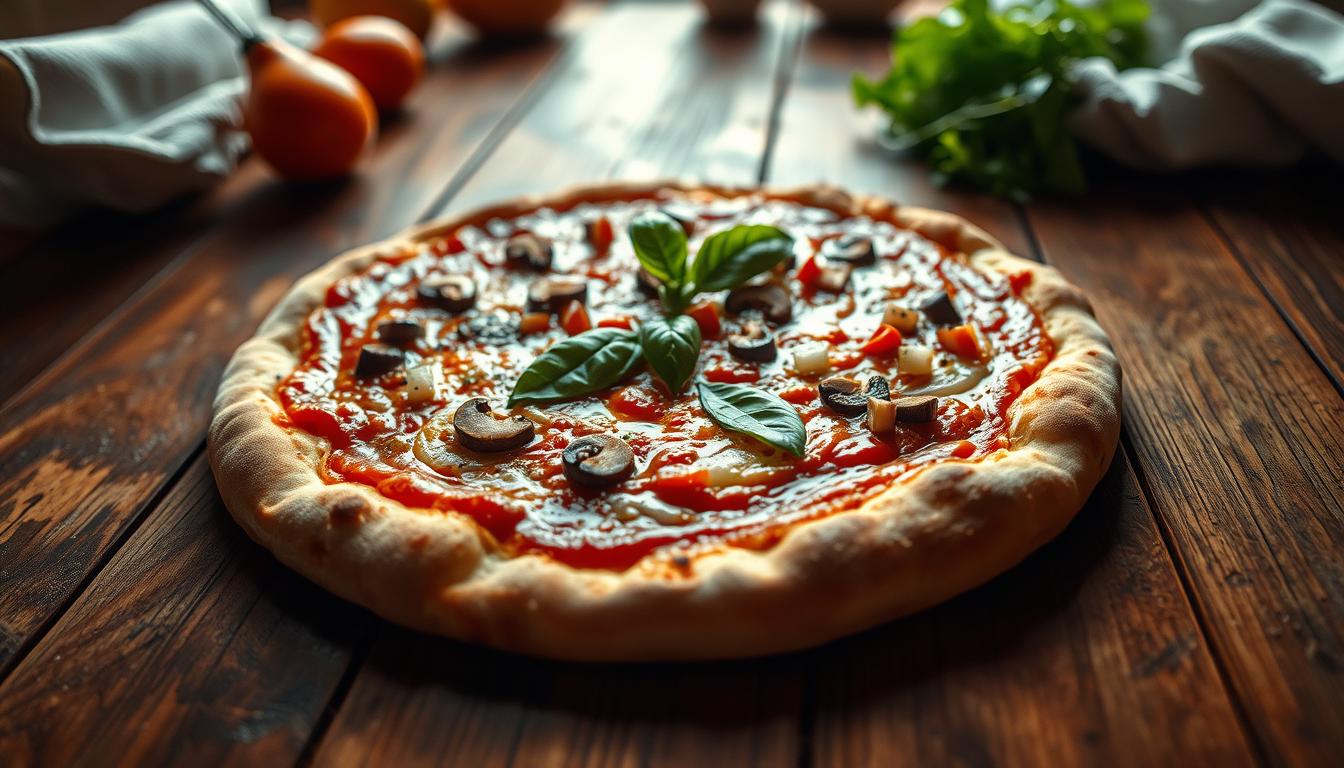Are you ready to elevate your cooking skills and enjoy a mouthwatering meal? Making homemade pizza allows you to explore an array of flavors while controlling the ingredients you use. This comprehensive guide offers insightful pizza tips and tricks for both novices and experienced cooks, ensuring a delightful pizza-making experience. By focusing on healthy ingredients and practical techniques, you can create a gourmet homemade pizza right in your kitchen. For a detailed recipe, check out this fantastic resource: Simply Recipes Homemade Pizza.
Key Takeaways
- Cooking pizza at home lets you control the ingredients for healthier meals.
- It’s a cost-effective way to enjoy gourmet pizza without breaking the bank.
- Investing in essential tools will greatly enhance your pizza-making skills.
- Choosing the right types of dough can significantly affect the final taste and texture.
- Creative toppings can take your homemade pizza from ordinary to extraordinary.
- Proper baking techniques are crucial for achieving the perfect crust.
Why Homemade Pizza Is the Best Choice
The trend of making pizza at home has gained popularity for good reasons. One of the most significant advantages is the ability to choose ingredients that align with personal health goals. Additionally, creating your pizza can lead to substantial savings compared to dining out.
Healthier Ingredients You Control
Making pizza at home grants you the freedom to select fresh and wholesome ingredients, providing a pathway to healthier pizza. By avoiding the preservatives and additives often present in commercial options, you can ensure each slice is nutritious. This control extends to dough choices, allowing for options like whole-grain bases or organic toppings, which contribute to a more balanced meal.
Cost-Effective Meal Option
Homemade pizza offers a smart solution for families looking to enjoy cost-effective meals. By purchasing ingredients in bulk, you can maximize value and create multiple pizzas at once, significantly lowering the overall cost of dining. The average expense per serving for homemade pizza frequently comes in lower than that of frozen pizzas or restaurant offerings, making it a budget-friendly choice without sacrificing flavor.
Essential Tools for Making Pizza at Home
Creating the perfect homemade pizza requires the right tools to ensure a smooth and enjoyable cooking experience. Selecting the right pizza-making tools can significantly elevate the quality of your finished product. Two items often debated among home chefs are the pizza stone and the baking sheet, each serving distinct purposes in the pizza-making process.
Pizza Stone vs. Baking Sheet
A pizza stone is designed to absorb moisture and distribute heat evenly, which results in a delightful crisp crust. This specific tool can enhance both the texture and flavor of the pizza significantly. On the other hand, a baking sheet offers more versatility but might not yield the same superior crust quality as a pizza stone. Each option has its merits, and choosing based on your cooking style can help achieve the desired outcome.
Must-Have Utensils
Equipping your kitchen with essential kitchen utensils is vital for an efficient pizza-making experience. Key items include:
- Rolling pin for dough preparation
- Pizza cutter for seamless slicing
- Mixing bowls for combining ingredients
- Dough scraper for easy handling and transfer
Investing in these tools simplifies the process and helps create mouthwatering pizzas every time. For further guidance on optimizing your pizza-making techniques, check out this comprehensive guide.
Choosing the Right Pizza Dough
Understanding pizza dough types is crucial to creating the perfect pizza experience. Each type offers unique qualities that cater to different tastes and preferences. Whether looking for a crisp bite or a hearty base, the choice of dough significantly impacts the overall enjoyment of your homemade pizza.
Types of Dough: Thin Crust vs. Thick Crust
Thin crust pizzas stand out for their crispy texture, allowing for a greater topping-to-dough ratio. This style is particularly appealing for those who enjoy a light and crunchy base. In contrast, thick crust pizzas provide a satisfying bite and ample space for garlic, herbs, and sauce. The density of thick crust makes each slice hearty, satisfying appetites after a long day. Choosing between these pizza dough types depends on personal preference and the overall pizza experience one desires.
Homemade vs. Store-Bought
When deciding between homemade pizza dough and store-bought options, several factors come into play. Making homemade pizza dough allows for complete control over ingredients, enabling personalization based on dietary needs or flavor preferences. On the other hand, buying pizza dough gives an easy solution for those short on time. Pre-made dough from brands like Pillsbury or Trader Joe’s often strikes a balance between convenience and taste, providing an excellent alternative for busy nights. Embracing either option can lead to delicious homemade pizzas that satisfy any craving.
Cooking Pizza: Techniques for Perfect Crust
To achieve that sought-after perfect pizza crust, mastering cooking pizza techniques becomes crucial. Start by preheating your oven to the ideal temperature of around 475°F to 500°F. This high heat promotes that characteristic crispy exterior while keeping the inside soft and chewy.
Another essential technique involves allowing your pizza dough to reach room temperature before spreading it out. This makes it more pliable and easier to stretch, enhancing the final texture. Using a pizza stone can also elevate your crust game. This tool retains heat well, mimicking the conditions of a professional pizza oven.
A specific baking time of 10 to 15 minutes is generally ideal, but keep an eye on your pizza. You’ll want to look for a golden-brown color, which signals that your perfect pizza crust is ready. For more detailed insights on timing and techniques, check this resource.
| Technique | Description | Benefit |
|---|---|---|
| Preheating the Oven | Heat the oven to between 475°F and 500°F | Achieves optimal crispiness |
| Room Temperature Dough | Let the dough sit out for about 30 minutes | Increases elasticity and ease of stretching |
| Using a Pizza Stone | Place a pizza stone in the oven while preheating | Mimics professional cooking conditions |
| Baking Time | Bake for 10 to 15 minutes | Ensures ideal color and texture |
Incorporating these cooking pizza techniques into your routine will undoubtedly lead you to create impressive pizzas with perfect crusts every time.
Tips for Selecting the Best Toppings
Choosing the right pizza toppings can transform a simple dish into a culinary masterpiece. With countless options available, understanding which toppings work well together is key to creating a truly delicious pizza. Whether you prefer classic toppings or want to explore unique flavors, there are important aspects to keep in mind to make your pizza experience unforgettable.
Classic vs. Unique Combinations
For many, classic topping combos such as pepperoni, mushrooms, and mozzarella are comforting staples. These well-loved choices offer a balance that satisfies traditional tastes. Exploring unique toppings can take your pizza to new heights. Ingredients like arugula, figs, or smoked salmon introduce an unexpected twist that can delight adventurous eaters. A diverse selection of pizza toppings allows for personalization, sparking great conversations and ensuring everyone finds something they enjoy at the table.
How to Balance Flavors
Balancing flavors is essential for a successful pizza. Mixing sweet, savory, and spicy ingredients can create a harmonious dish. For instance, pairing spicy pepperoni with sweet bell peppers enhances the overall flavor profile. Texture plays a vital role; incorporating crunchy vegetables alongside creamy cheeses adds depth and satisfaction. When done well, balancing flavors with various pizza toppings can elevate even the most basic pizza into a standout meal.
Homemade Pizza Sauce Recipes
Creating the perfect pizza starts with the right sauce. Whether you prefer a classic tomato base or a rich white sauce, learning various pizza sauce recipes can elevate your homemade pizza experience. Below are two popular options that showcase the diversity of flavors you can achieve.
Traditional Tomato Sauce
A staple for many homemade pizzas, traditional tomato sauce is simple yet flavorful. To make a delicious homemade tomato sauce, use high-quality canned San Marzano tomatoes, garlic, olive oil, salt, and fresh basil. The combination of these fresh ingredients offers a robust flavor that complements a variety of toppings.
White Sauce Variations
For those seeking an alternative to tomato-based sauces, white sauce pizza provides a creamy and decadent option. By mixing cream, garlic, and Parmesan cheese, you create a sauce that adds richness to gourmet pizzas. This variation pairs beautifully with toppings like vegetables and seafood, allowing for a unique twist on traditional recipes.

| Sauce Type | Main Ingredients | Best Pairings |
|---|---|---|
| Traditional Tomato Sauce | Canned tomatoes, garlic, olive oil, salt, basil | Pepperoni, cheese, vegetables |
| White Sauce | Cream, garlic, Parmesan cheese | Chicken, spinach, seafood |
Cheese Choices for Your Pizza
When it comes to crafting the perfect pizza, cheese plays a pivotal role in achieving just the right flavor and texture. Selecting the ideal cheese types for pizza can elevate your dish from ordinary to extraordinary. Understanding the melting properties of various cheeses can provide insights into how they enhance your pizza experience
Melting Properties of Different Cheeses
Mozzarella stands out as the quintessential pizza cheese, revered for its remarkable melting qualities. It creates that gooey, stretchy texture that pizza lovers crave. Other cheese types for pizza, such as provolone and gouda, can create a delightful combination with mozzarella, offering a richer flavor profile and a unique texture. When mixed, these cheeses not only melt beautifully but also contribute a depth that enhances the overall taste of your pizza.
Adding Flavor with Specialty Cheeses
Incorporating specialty cheeses into your pizza can significantly amplify its flavor. Cheeses like feta, goat cheese, and blue cheese provide distinct tastes that contrast and complement other toppings. Their unique profiles can add exciting notes, inviting adventurous palates to explore new culinary experiences. Strategically placing these specialty cheeses atop your pizza not only improves flavor but also enhances visual appeal, making each slice a feast for both the eyes and the taste buds.
Mastering the Art of Baking Pizza
Baking pizza is an art that combines the right temperature with precise timing. Achieving that perfect crust and bubbling topping requires attention to detail. Understanding the optimal pizza oven temperature and how to use essential tools like a pizza peel can enhance your pizza-making experience.
Oven Temperature and Baking Times
The ideal temperature for baking pizza lies between 475°F and 500°F. This range allows the crust to become crispy while ensuring that toppings are cooked thoroughly. Baking times vary based on the thickness of the crust and the toppings chosen, generally falling within a range of 10 to 15 minutes. A well-regulated pizza oven temperature ensures a beautifully baked masterpiece.
Using a Pizza Peel for Optimal Placement
A pizza peel serves as a crucial tool for transferring your pizza to and from the oven without disrupting the toppings. To make the process smoother, dust the peel with flour or cornmeal. This simple step prevents sticking and guarantees a hassle-free way to achieve that delightful crust when baking pizza.

Creative Pizza Presentation Tips
Enhancing pizza presentation transforms an ordinary meal into a visual feast. Utilizing effective garnishing techniques elevates both flavor and aesthetics, making your homemade pizza stand out. From fresh herbs to unique serving ideas, the right approach can change how your pizza is perceived and enjoyed.
Garnishing Techniques
Garnishing pizza is an art that can substantially enhance the dish’s appeal. Consider topping your pizza with:
- Fresh basil leaves for a burst of flavor and color.
- Arugula to add a peppery kick and freshness.
- A drizzle of balsamic glaze for a sweet and tangy finish.
- Shaved parmesan cheese for an extra layer of richness.
These garnishes not only improve the visual impact but also create exciting flavor combinations that entice the palate.
Serving Suggestions
When it comes to serving pizza, think outside the traditional slice. Here are some ideas to enhance the experience:
- Cut the pizza into various shapes to cater to different appetites.
- Pair with side salads for a refreshing contrast.
- Offer garlic bread for a hearty accompaniment.
- Present on wooden or slate boards for a rustic feel.
These serving suggestions can make the meal feel more complete and enjoyable, turning a simple dinner into a memorable occasion.
Conclusion
Making pizza at home is not just a culinary task; it’s an experience that brings families and friends together. By implementing the pizza tips and tricks highlighted in this article, you can elevate your cooking skills and create mouthwatering pizzas that suit your taste and preferences. From selecting the right dough to mastering the perfect baking technique, there are endless possibilities to explore.
When you’re enjoying homemade pizza, you’re not only savoring delicious flavors but also embracing a healthier and more personalized meal. Experimenting with various toppings, cheeses, and sauces empowers you to craft a pie that reflects your unique palate. Whether you prefer classic pepperoni or adventurous gourmet combinations, the joy of making your own pizza is unmatched.
So, gather your loved ones, roll out the dough, and showcase your creativity in the kitchen. With each pizza you create, you’re not just serving a meal—you’re building lasting memories. Dive into the world of homemade pizza and discover how satisfying and fun it is to share your creations with those you care about.
FAQ
What are the healthiest ingredients I can use for homemade pizza?
Using fresh vegetables, lean proteins like grilled chicken or turkey, low-fat cheese, and whole-grain crust are excellent choices. Opting for organic toppings also lets you control the quality of your ingredients, making your pizza healthier.
How can I make my pizza crust extra crispy?
To achieve a crispy crust, preheat your oven to a high temperature (around 475°F to 500°F), and consider using a pizza stone to absorb moisture. Allowing your dough to rest and come to room temperature before baking can also enhance the crust’s texture.
Is it worth making my own pizza dough instead of buying pre-made?
Homemade pizza dough allows for customization in taste and texture, often resulting in a fresher product. However, store-bought options, like those from Pillsbury or Trader Joe’s, can be convenient if you’re short on time while still providing great flavor.
What toppings should I choose for a gourmet pizza experience?
Combining classic toppings like mozzarella and pepperoni with unique ingredients such as figs, arugula, or goat cheese can elevate your pizza. Experimenting with flavors and textures will lead to exciting and delicious combinations!
How can I balance flavors on my homemade pizza?
The key to balancing flavors is to mix sweet, savory, and spicy elements. For example, pairing spicy toppings like jalapeños with sweetness from caramelized onions can enhance your pizza’s overall taste. Incorporating various textures, such as crispy vegetables and creamy cheeses, adds to the experience.
What are some creative presentation tips for serving pizza?
Garnish your finished pizza with fresh herbs like basil or a drizzle of balsamic reduction to enhance visual appeal. Cutting the pizza into varying sizes can also cater to different appetites and makes for an inviting presentation at gatherings or parties.
How important is the type of cheese I use on my pizza?
The type of cheese significantly impacts both flavor and texture. Mozzarella is the go-to for its melty quality, but combining it with specialty cheeses like gouda or feta can create a unique flavor profile and enhance your pizza experience.
